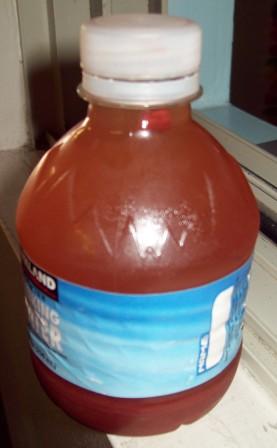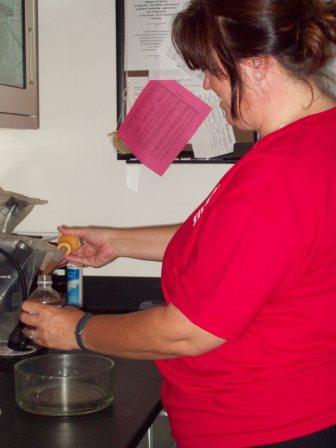
Captured blue whale poop
I know what you are thinking, why on earth would anyone want to capture blue whale poop? But when it comes to science and knowing more about whales, anything goes. The blue whale poop in the photo was scooped up by Eric Martin, Facility Director & Educational Co-Director at the Roundhouse Aquarium. He then threw the bottle to Cabrillo Marine Aquarium Program Coordinator Diane Alps, but it went flying over the boat and landed in the water with a great splash, scaring those of us standing on that side.
Eric then swung his boat around to grab the bottle and make a second pass and this time success! On Tuesday, Alps transferred the blue whale poop to a lab bottle and filled it with ethanol to preserve it. The process was simple, but smelled awful. I’m talking choke on the air, gag and run for the door awful. But then again what did I expect, it is poop after all.

Diane Alps tranferring whale poop
Diane was brave and didn’t flinch once, I on the other hand stayed near the door. The next step is to put some of this bright red blue whale poop under the microscope and see what there is to see.
Blue whale poop gets that red color from the whale’s diet of krill, tiny shrimp-like creatures that are reddish-pink in color. But I’ve seen krill and they don’t seem as red as what’s in that bottle, but a whale eats tons of krill. So apparently all that begins to add up in the digestive system and has to go somewhere.
For more information on the importance of whale poop to the ocean’s ecosystem here’s a link to more about it’s high iron content and one to the role it plays in absorbing carbon from the atmosphere. I will keep you posted on what the microscope reveals.
Can’t wait for the next installment when the mystery is revealed. I don’t how I lived before this not knowing about red whale poop. However I couldn’t help but notice that it was scooped into a dreaded plastic bottle!
Whales eat tons of krill, whales need tons of krill to survive; I’m concerned about the nutrition industry – I’m seeing more and more advertising about products made from krill. Hopefully it becomes too cost prohibitive to manufacture
Hi Susie, I’ve been concerned about this trend as well. So far I haven’t seen anything that says krill is being overfished, but I continue to monitor the issue.
Hi! So interesting! but what about the microscope results? There is any link to see what it was on the sample? 😀
Hi Anna, Alas, I don’t have access to the microscopic results.